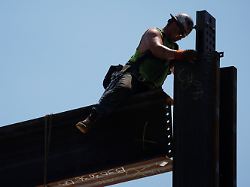More jobs than staff
Significantly more new jobs in the USA than expected
5/5/2023 4:32 p.m
Within a year, the US Federal Reserve raised interest rates from zero to more than 5 percent. So far, this has had no impact on the labor market. The unemployment rate falls to its lowest level in 70 years. Now the question might arise as to how serious the Fed is about flirting with interest rate pauses.
Despite the series of rate hikes by the central bank, the US job engine is still running at full speed. In April, 253,000 new non-agricultural jobs were added, according to the government in Washington. Economists had only expected an increase of 180,000. However, the increase in jobs in March was not as strong as originally reported – the number was reduced by almost a third to 165,000 by the ministry. The separately calculated unemployment rate fell in April to 3.4 percent in March. Experts had expected a slight increase.
“It cannot be denied that the labor market is still very tight,” concluded Commerzbank experts Christoph Balz and Bernd Weidensteiner. As a result, significantly more jobs would continue to be created when new people entered the labor market: “Accordingly, the unemployment rate has fallen again – it was last lower in 1953,” explained the bank economists. The unemployment rate in the USA has been fluctuating between 3.4 and 3.7 percent for around a year after rising massively in the wake of the corona pandemic.
The labor market in the US is proving to be surprisingly resilient, says Helaba economist Ulrich Wortberg. In view of a job growth of more than 250,000 and a falling unemployment rate, one cannot speak of a weakness. As a rule of thumb, an increase of 70,000 to 100,000 jobs per month is sufficient to provide jobs for the growing US working-age population.
Wages rise by 4.4 percent
The Federal Reserve has pushed interest rates from near zero to a range of 5.00 to 5.25 percent since early 2022 in a bid to stem high inflation and cool the overheated labor market. Now she’s heading for a break. Even if higher interest rates are already dampening economic output, Fed Chair Jerome Powell believes a recession scenario is less likely. Should it nevertheless come to that, he is counting on a mild course – also with a view to the development on the labor market.
On inflationary pressures, the Fed is also turning its attention to wage growth. Average hourly wages increased by 4.4 percent year-on-year in April, after 4.3 percent in March. Experts had only expected an increase of 4.2 percent.
The situation on the US labor market is only cooling off very slowly, says economist Bastian Hepperle from Hauck Aufhäuser Lampe Privatbank: “Patience is required until the cooldown is reflected in weaker wage developments. This prevents a greater drop in pressure in the inflation pipeline .” The Fed will therefore continue to flirt with an interest rate pause, but will not say goodbye to it yet. Inflation fell a full point to 5.0 percent in March, the lowest level since May 2021. The Fed can take this as a partial success, but the 2.0 percent inflation target is still a long way off. After the latest interest rate decision, Powell emphasized that inflationary pressures are still high. There will probably still be a long way to go before the target is reached.
